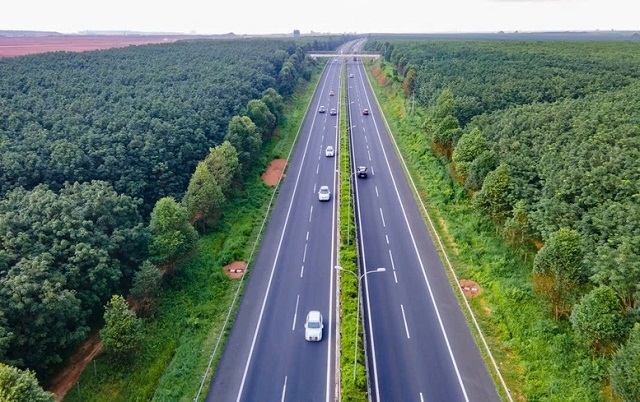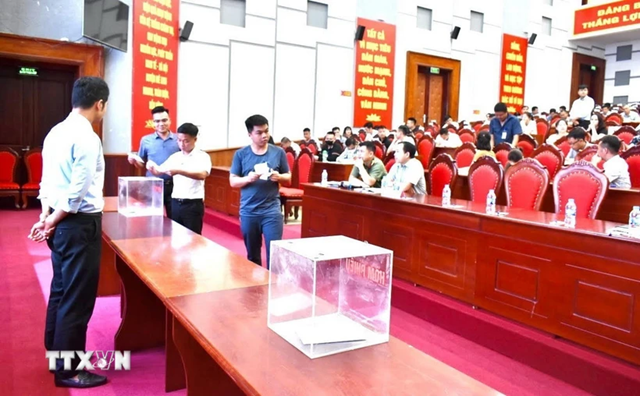In a recent report on the expansion of the Hochiminh City – Long Thanh Highway section as an emergency construction project, the Vietnam Expressway Corporation (VEC) announced that after being assigned by the government as the managing authority, VEC has submitted a proposal to the Ministry of Finance regarding the structure of the state budget investment in the project, along with detailed calculations of financial plans and feasibility assessments of the company’s capital balance.

The proposed expansion of the Hochiminh City – Long Thanh Highway section as an emergency construction project – Photo by Ta Hai
|
Large-scale project with complex construction requirements
According to VEC, this is a large-scale project with complex technical requirements and construction conditions, including at least eight months of land improvement for a 10-kilometer section, 12 kilometers of bridges, and ensuring uninterrupted traffic on the operational expressway during construction.
Following the legal regulations on public investment, construction, and bidding, the project implementation would require three steps before commencement: approval of investment policy, approval of investment project, and approval of construction drawings and cost estimates to serve as a basis for contractor selection.
With this procedure, the project is expected to commence on November 1, 2025, with substantial completion by December 2026. The Long Thanh Bridge is expected to be finished and operational by June 2027.
Among these tasks, the critical factor determining the project’s progress is the environmental impact assessment, as the project passes through the territories of two localities.
Commencement on August 19 with streamlined procedures
Aiming to commence the project on August 19 to commemorate the 80th National Day on September 2, VEC, based on current legal regulations, proposes that the government considers and decides to apply five special mechanisms for the implementation of the Hochiminh City – Long Thanh Highway expansion project.
Firstly, VEC requests permission to apply a streamlined direct contracting procedure.
Secondly, VEC seeks approval to simultaneously carry out procedures for surveying and project development, designing construction drawings and cost estimates, contractor selection, construction, and other necessary tasks.
Thirdly, VEC proposes that the Prime Minister decides to separate the land clearance work into independent sub-projects and assigns Hochiminh City and Dong Nai Province to implement them. VEC will allocate funds for payment and settlement according to the needs and progress proposed by the localities.
Fourthly, the local authorities where the project passes through are requested to prioritize support in determining and agreeing upon waste disposal sites, material stockpiling areas, temporary wharves, temporary locations for asphalt and cement mixing plants, and necessary permits during the construction phase. They are also expected to ensure a sufficient supply of construction materials during the project’s execution.
Fifthly, VEC proposes that in case of force majeure events, such as shortages of construction materials, difficulties in land clearance, natural disasters, or epidemics, the government allows for adjustments to the project timeline for the affected parts.
If the Prime Minister decides to approve the implementation of the project as an emergency construction project and permits the application of the above special mechanisms, the project will benefit from five advantages: no need for investment policy approval, immediate commencement of surveying and feasibility study report development (without the need for an environmental impact assessment report), simultaneous implementation of land clearance and staking, simultaneous design and construction, and simultaneous contractor selection and construction, leading to a shortened construction period.
In this case, the project approval is expected to be completed by July 2025, with construction drawing approvals starting from August 8, contractor selection on August 13, and project commencement on August 19, 2025.
Following this timeline, the section from Vanh Dai 2 Junction to Vanh Dai 3 Junction (Km4+000 – Km8+844.5) will be expanded from four to eight lanes, with a construction period of 13 months and completion in September 2026.
The section from Vanh Dai 3 Junction to the Bien Hoa – Vung Tau Expressway Junction (Km8+844.5 – Km25+920, excluding Long Thanh Bridge) will be expanded from four to ten lanes, with a construction period of 14 months and completion in October 2026.
As for the Long Thanh Bridge, it will take 20 months to construct, with the main span completed by December 2026 and the remaining items finished by March 2027.
“Thus, in the case of implementing the investment as an emergency construction project and applying certain special mechanisms and supportive policies, the project timeline can be shortened by 2.5 months, allowing for a commencement date of August 19, 2025, and substantial completion in 2026,” VEC stated.
It is known that based on VEC’s proposal, the Government Office recently (on May 16) issued Document No. 4279 to the Ministry of Finance, the Ministry of Construction, and VEC, conveying the direction of Deputy Prime Minister Tran Hong Ha, assigning the Ministry of Finance to take the lead in coordinating with the Ministry of Construction and related agencies to consider and report to the Prime Minister before May 21, 2025.
– 11:40 19/05/2025
The Art of Seamless Traffic Diversion on the Cau Gie – Ninh Binh Expressway
The Vietnam Expressway Corporation has announced a temporary traffic management plan for the Cau Gie-Ninh Binh Expressway (Km239+800 to Km242+900 stretch) effective from December 6. This plan will ensure the safety of motorists during the construction of the Lien Son Interchange flyover in Ha Nam province.




















